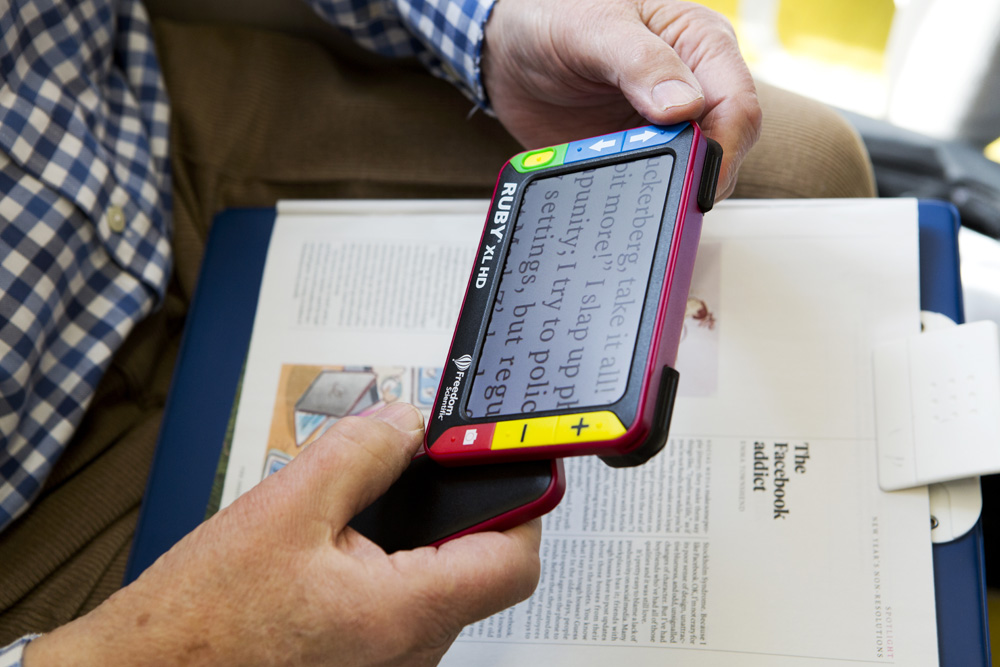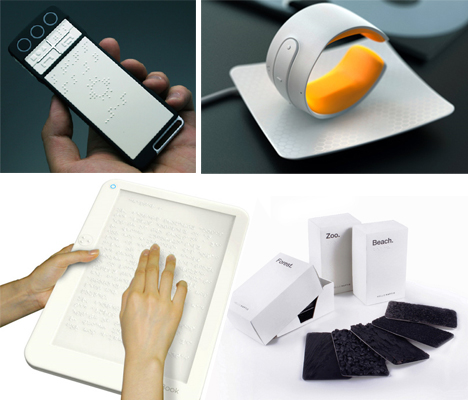Discover Cutting-edge Tools Created for the Aesthetically Damaged
The growth of ingenious tools for the aesthetically impaired represents a significant advancement in accessibility and independence. Technologies such as smart glasses with AI abilities and mobile applications made to supply acoustic descriptions are reshaping everyday experiences for customers. Furthermore, wearable gadgets that employ haptic responses enhance environmental understanding, while modern-day Braille advancements offer brand-new ways to engage with text. As these devices remain to develop, their effect on the lives of those with visual disabilities elevates vital inquiries regarding the future of inclusivity and autonomy in different aspects of life. What lies ahead in this technical landscape?
Smart Glasses for Navigating

Smart glasses developed for navigating are transforming the means visually impaired people engage with their setting. These sophisticated gadgets make use of a mix of camera modern technology, fabricated intelligence, and auditory responses to supply real-time info concerning environments. By using barrier discovery systems, clever glasses can inform users to possible threats, allowing more secure movement in both strange and familiar setups.
The combination of GPS technology better boosts navigation capabilities, permitting users to get auditory instructions as they relocate. This hands-free method not only cultivates independence but likewise encourages visually impaired people to navigate metropolitan landscapes with increased self-confidence. Additionally, several wise glasses are furnished with attributes that determine sites and road indications, supplying contextual info that enhances the customer experience.
Additionally, the advancement of these devices is consistently progressing, with firms functioning to enhance the accuracy of item recognition and expand the series of navigational functions. As wise glasses end up being extra economical and easily accessible, they hold the prospective to significantly change life for visually damaged users. Inevitably, these ingenious tools represent a critical step towards inclusivity, offering boosted wheelchair and a higher feeling of freedom for individuals navigating the world around them.

Mobile Apps for Daily Living
Exactly how can mobile applications enhance the day-to-days live of visually impaired people? Mobile apps are transforming the method aesthetically damaged users navigate their atmospheres, handle daily tasks, and access details. These applications supply vital support with various functionalities, cultivating self-reliance and improving lifestyle.
Several innovative mobile applications are designed particularly for day-to-day living. For example, apps like Be My Eyes attach aesthetically damaged customers with sighted volunteers via video clip calls, enabling them to obtain real-time help with jobs such as reviewing tags or navigating strange spaces. Likewise, Seeing AI, developed by Microsoft, utilizes synthetic intelligence to describe surroundings, reviewed message, and identify things, properly transforming a smart device into an effective tool for day-to-day support.
In addition, navigating applications tailored for the visually damaged, such as Aira and BlindSquare, use audio-based instructions and ecological info, allowing users to traverse their environments safely and with confidence. Beyond navigation and instant help, mobile applications likewise support organization and task administration, with attributes that help individuals set reminders, develop order of business, and track consultations. In summary, mobile applications work as essential resources, equipping visually damaged individuals to lead even more independent and satisfying lives.
Wearable Technologies for Aid
Empowerment with innovation is increasingly obvious in the realm of wearable tools developed to help visually impaired people. These innovative devices incorporate flawlessly right into day-to-day life, improving navigation and offering necessary comments to individuals. Smart glasses equipped with cams can read and recognize faces text aloud, enabling individuals to engage even more with confidence in professional and social settings.
Another noteworthy improvement is using haptic comments systems in wearable tools. These systems utilize resonances or various other responsive signals helpful site to communicate details about the individual's atmosphere, such as challenges or modifications in terrain, enhancing movement and safety and security. Wearable technologies likewise include wristbands that attach to mobile phones, signaling users to notices with subtle resonances, thus enhancing connectivity without reliance on visual hints.
As these technologies remain to advance, they are not only improving self-reliance for aesthetically damaged people but also fostering a better feeling of addition in culture. By connecting the gap between challenges encountered in daily living and the potential for autonomy, wearable innovations act as critical tools in the pursuit for equality and empowerment for those with aesthetic impairments.
Audio Description Tools
Audio description tools play an essential duty in enhancing ease of access for aesthetically damaged people, offering them with the ability to engage with visual media. OCR devices for the blind. These tools offer narrated descriptions of key visual elements in films, tv shows, and live efficiencies, ensuring that users can fully comprehend the context and emotions conveyed via visuals
Sound description can be integrated into numerous systems, consisting of streaming services, cinema screenings, and live theater. Numerous prominent streaming services now include audio summary as an ease of access function, enabling audiences to select it easily. In addition to mainstream media, specialized apps also exist, providing audio descriptions for art exhibits, museums, and other cultural occasions.
The effectiveness of audio description rests on the skill of the narrators, who should click for info communicate aesthetic information succinctly without diminishing the initial audio. Innovations in this area are additionally leading the means for more individualized experiences, where customers can adjust the level of information and pacing according to their choices.
Braille Innovations and Devices
Braille devices and developments have actually dramatically transformed the way aesthetically impaired people connect with message and info. Modern advancements have led to the growth of versatile devices that enhance literacy and freedom amongst users. Notably, Braille show modern technologies have progressed, enabling vibrant analysis experiences. These gadgets convert digital text into Braille, allowing customers to access a vast range of info on mobile phones, computer systems, and tablets.
Moreover, mobile Braille notetakers incorporate standard Braille input with modern functionalities, facilitating note-taking, organizing, and record editing and enhancing on the move. Braille displays and notetakers. These portable gadgets typically include text-to-speech abilities, connecting the void between Braille and acoustic information
In addition, cutting-edge Braille printers have arised, enabling customers to create Braille tags, papers, and instructional materials effectively. This accessibility cultivates higher participation in professional and instructional atmospheres, ultimately advertising inclusivity.
Additionally, research right into smart Braille modern technologies remains to expand. Instruments that include man-made intelligence are being explored to supply real-time navigation aid and contextual info, enhancing the customer experience in diverse setups. Overall, these technologies show a dedication to equipping aesthetically impaired people through innovation, ensuring they can easily gain access to and involve with the globe around them.

Final Thought
The development of ingenious devices for the visually damaged considerably enhances self-reliance and lifestyle. Smart glasses, mobile applications, wearable innovations, audio summary devices, and Braille developments jointly encourage individuals by supplying necessary navigation aid, ecological awareness, and enhanced reading experiences. These modern technologies not only foster higher inclusion yet also advertise autonomy in everyday tasks, eventually contributing to a more fair and accessible culture for visually damaged people. Continued advancement in this area holds guarantee for additional improvements.
As wise glasses come to click this link be more inexpensive and easily accessible, they hold the possible to significantly transform everyday life for aesthetically damaged users. Mobile apps are transforming the method visually impaired individuals browse their settings, take care of day-to-day tasks, and access info. Apps like Be My Eyes link aesthetically damaged customers with sighted volunteers via video calls, enabling them to get real-time help with jobs such as checking out tags or browsing unfamiliar spaces.Additionally, navigation apps tailored for the aesthetically damaged, such as Aira and BlindSquare, offer audio-based directions and environmental information, enabling users to traverse their environments securely and with confidence.The innovation of cutting-edge devices for the aesthetically damaged substantially improves self-reliance and high quality of life.